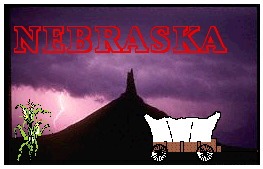
OCTA publishes a variety of materials and maintains a large bookstore of western history resources. Additionally, volunteers have been surveying emigrant documents for several years to construct a computerized database for studying the emigrant experience. The database can also help genealogists locate information about their emigrant ancestors.

Events in 2005 Events in 2006 Events in 2007
Go to Top
NEBRASKA Trail Sites
These Nebraska sites are listed by absolute geographic location, from east to west, as emigrants would
have encountered them in the 19th century. If you would like to have the list appear in another format, please let us know. Obviously, not all Oregon - California sites are listed here. If you would like to contribute information
or graphics for Nebraska sites, listed or not listed here, please contact the WebMeister.
'Boys, said the leader, we'll turn aside
And so the line
of a great railroad was turned to the west that she might lie in peace in the
little grave she had occupied these many years, for she was one who came with
the Morman migration in 1847."
However, her grave was
relocated in 1996 1/4 mile (400 m) east near the state historical marker,
between Highway 26 and the railroad, 3 miles (4.9 km) east of
Scottsbluff.
Here, close by the trail, her grave shall stay
For she came first in
this desert wide
Rebecca Wright holds right of way.'
The Oregon - California Trails
exit Nebraska at the village of Henry, Scottsbluff County, continuing west into
Wyoming.
Go to Top
Links to other sites : OCTA and its chapter sites
Please contact OCTA for current officers, events of the past, present and future.
Non - OCTA but Trails related sites :
eMail: gnelson AT inentebr.com Webmeister : Greg Nelson Visit Greg's Home Page
and is viewable using any browser